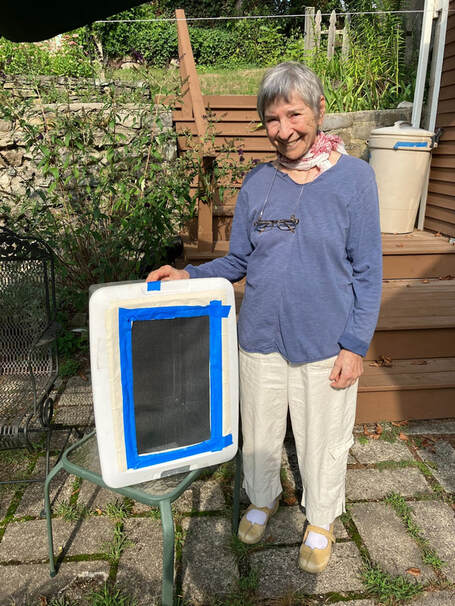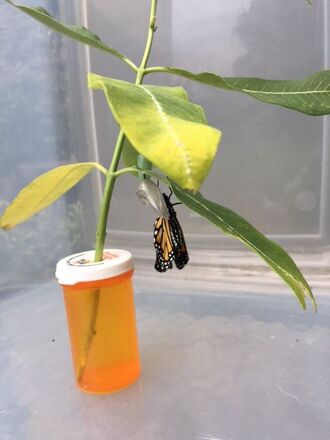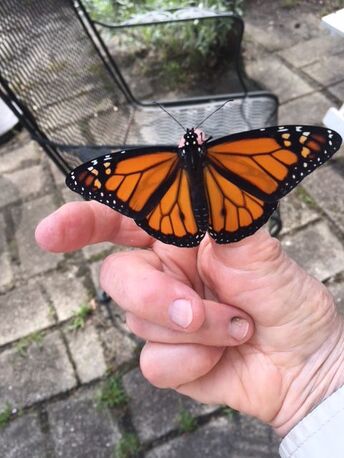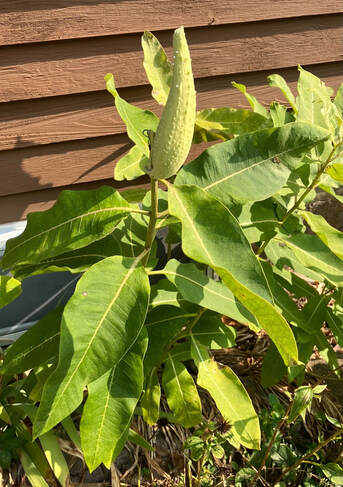|
How long have you lived in Hyde Park? In what ways are you involved in the community? I came here in 1998, so I’ve lived here for 24 years. I love to walk in the Stony Brook Reservation and enjoy the wildflowers and birds I find there. I support the library and I tutor a person in English at the library through Jewish Vocational Services, an organization that helps people with education and jobs. They are based in Boston and have a satellite location at the Hyde Park library. When did you become interested in butterflies and how did you learn how to raise them? I’ve been interested in butterflies for about 15 or 20 years. My interest started with a course I took at the Massachusetts Audubon Society. I learned a lot about butterflies there, especially because we took many field trips to see butterflies in their native habitats. I’ve been lucky to meet a woman named Madeline Champagne who loves to help people raise these butterflies. She also educates kids in schools about the life cycle of the Monarch butterfly. Teachers sometimes order butterfly caterpillars from for-profit places, but they're not healthy when they’re raised that way. They can be studied in the wild, or raised from a wild egg, to become a caterpillar and then a chrysalis in the classroom and then released to the outdoors. You can raise Monarchs at your home, and can do this also with Black Swallowtail butterflies. The food plant for the caterpillar is what’s necessary. They can’t eat just any leaves, they have to eat just certain leaves. The Black Swallowtail caterpillar eats leaves of the carrot family which includes parsley, dill, and Queen Anne’s Lace, among others. I had some dill growing once and I found a caterpillar on it, which was really exciting. The Black Swallowtail caterpillar is so beautiful. What are the stages and steps involved with raising a butterfly? There are 4 stages: egg, caterpillar, chrysalis and butterfly. When Monarch butterflies fly through your garden, the female wants to deposit its egg and it needs to find a Milkweed plant. This plant is called Milkweed because if you break it off anywhere, the sap looks like milk. The Milkweed flower is attractive to all insects and it blooms in the spring. Milkweed leaves are the important part of the plant that Monarch caterpillars need to eat and grow. The female butterfly will look for places to lay its egg - usually on the younger leaves of the Milkweed plant. It will curl its abdomen onto the underside of a leaf and deposit an egg that looks like a tiny little, creamy white dot. I watch the female as she flies around the milkweed plants to see where she deposits her egg. Then I cut off the part of the plant that has the leaf with the egg on it and bring it inside and put it in a small container with water. I use a prescription pill bottle; I’ve punched a hole in the cover just big enough for the stalk that has the leaf with the egg on it. I place that in a cage that I made out of a plastic bin and a screen (see photo). After about 5 days, the egg will hatch into a tiny little caterpillar. For the next two weeks it will eat many leaves from the Milkweed plant, starting with the leaf it was brought in on. As it eats and grows, I’ll have to bring in more leaves. There will be lots of leaves in the cage. The caterpillars are eating and pooping machines during those two weeks. They grow to the size of your pinky after about two weeks. They are very beautiful, with yellow and black markings. After about two weeks their behavior changes; often they will get active and race around the cage and then they get very quiet and still. Soon they secrete a substance that helps them hang from the top of the cage or from a leaf. Next, you’ll see the caterpillar has formed into the shape of a J, hanging from the roof of the cage or from the sturdy rib of a leaf. After about a day the J starts to shake and move and all of a sudden it sheds its skin and a chrysalis emerges. It takes a couple hours for the completed chrysalis to be formed. It’s an apple green color with glittering gold dots - it is so beautiful, like a jewel. The chrysalis will hang from its place in the cage and after about two weeks you’ll notice that the chrysalis will change from its beautiful apple green color and will start to get dark. At the point where the butterfly is about to emerge from the chrysalis you’ll start to see the butterfly’s black and orange colors in the chrysalis. That’s when I take the cage outside so the butterfly doesn’t get out in the house, which happened to me once. Outside, I set it in the shade because it is usually a hot day and I leave the screened cover open. When it is ready, the butterfly will emerge from the chrysalis (which is now transparent and looks like plastic); it will hang on to the now empty chrysalis by its feet for a couple hours to dry its wings before flight. It dangles and dries its wings for 3-5 hours, then it will start to open and flap its wings indicating it is getting ready to go. At this point, the butterfly is ready to leave the cage. If you are lucky, it will walk onto your finger and you can take it out of the cage on your hand. Many times the newly emerged butterfly will stay in nearby bushes for a short while when it takes its first flight but when it is ready to take off, you’ll see it fly off into the wide blue sky to begin its journey. It is beginning a flight toward the Oyamel Mountains in Mexico where Monarchs go to roost with thousands of other Monarchs who also have migrated to spend the winter in this unique fir forest. Are there any predators when you take the cage outside and open it? I wondered about that at first. But the adult Monarch’s bright orange color is a warning color to other animals. Predators know to stay away from creatures that are orange because they are poisonous. So now I don’t worry about them. When does the butterfly season begin and end? Monarchs first get here in late June or July. When they come to my garden, I go out to see if one is depositing eggs. Usually Monarchs stop depositing eggs around late September and October because they need to start their migration and make their way down to Mexico and the forest where they will be in the winter. In the Oyamel forest there are trees filled with thousands of roosting Monarchs. In the spring these Monarchs will begin their migration to the north and by July we will see them again. Aside from Milkweed and Butterfly Bushes, are there other plants that are important to have for the butterflies? The only essential plant for the Monarch is Milkweed, its caterpillar food plant. But butterflies will sip nectar from just about any flower. As with most butterflies, they seem to especially love the flowers of butterfly bushes (Buddleia davidii.) Why not just let this process happen outside in nature? Monarch eggs are subject to predators which include other insects. Caterpillars may also be endangered by predators in the wild. You can help Monarchs survive if you take them in the house to raise them, and then release the butterflies to the wild. How many butterflies do you raise each season? Well, this season I think there were between seven and nine. I have raised more Monarchs in other years. Often I’ll have multiple Monarch caterpillars at different stages of growth at one time. If I take a vacation away from my home, I give the cage to a friend to keep an eye on things, to put in more leaves or to release the butterfly if it is out of the chrysalis and ready to fly. If someone wanted to start doing this, what would you suggest? I’d say find Milkweed seeds. Look for pods on existing plants and distribute the seeds around an empty place in your garden. Milkweeds have beautiful little brown seeds with fluffy hairs attached that carry them in the wind. There are different kinds of Milkweed plants and butterflies like some more than others. Common Milkweed (Asclepias syriaca) is the one you will most often find in open meadows. In the fall you can collect the mature pods on these plants and when the seeds are bursting out of the pod, you can scatter them in your garden. When the seeds sprout and grow, and you have Milkweed plants in your garden, the Monarchs will come. Another variety in my garden is called Butterfly Weed, (Asclepias tuberosa). It has a spectacular orange flower and grows very well. But most of the Monarchs I see place their eggs on Common Milkweed.
I’d be glad to answer questions, so feel free to email me any questions you may have. [email protected]. _________________________________________________________ Nominate yourself or someone in the community for a Humans of Hyde Park story; nominees can remain anonymous in the story or use their first name only if they prefer: https://goo.gl/forms/qgTj1Rh8t2bSbh973
4 Comments
|
Details
AuthorQuiana first came to Boston as a college student, graduating from Wellesley College in 2002 and returned in 2016 to live in Hyde Park with her husband and two children. Archives
October 2022
Categories |




 RSS Feed
RSS Feed